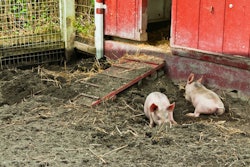
Although computers and feed formulation programs abound, it is imperative for future feed professionals to know the inner workings of formulation.
Learning how to balance a simple, yet complete, animal feed should be one of the focal points in teaching nutrition at any college.
Lamentably, this is not always the case. Even in cases where such endeavor is undertaken, most students learn by using computer software, with all its potential and limitations. The student may not realize how the software works and as a consequence why the result may be infeasible, impractical or even unreasonable.
I have prepared a very quick outline on how to create a simple broiler feed using the very basic feed ingredients needed. This is an example and should not be used under commercial conditions as broilers require more than one feed, and those feeds need to be balanced for even more nutrients than shown here, plus some additives. But, let us begin this classroom example.
-
The problem
We will assume the ingredients in the table are available without limitations on quantity usage levels, and that their nutrient composition is as shown. With these ingredients, and ignoring the principle of least-cost formulation, we will formulate a diet that is balanced only for the nutrient specifications at the bottom of the table. Some ingredients will be added at the indicated fixed inclusion level recommended by their supplier, as shown in the far-right column.
-
The solution
We begin with the assumption that the two major ingredients to be used, corn (a) and soybean meal (b), will constitute 95% of the total, with everything else bringing up the rest. With this in mind, we have our first equation (1). As these two ingredients are the only source of protein, we can construct our second equation on protein (2), and then use algebra to resolve the problem as follows:
(1) a+b=95.0
(2) 8.8a+44.0b=18.0
Solution (rounded): a=67.5, b=27.5, meaning 67.5% corn and 27.5% soybean meal
We will then calculate the amount of soybean oil (c) required to bring dietary energy to the desired level through equation (3) as follows:
(3) 3300a+2430b+9200c=3000
Solution (rounded): c=1.2, meaning 1.2% added soybean oil
The next steps are similar, and we should do them in this order: phosphorus using dicalcium phosphate, then calcium using calcium carbonate, but including the amount of calcium provided by dicalcium phosphate, and finally salt. The resulting values are then as follows: dicalcium phosphate=1.75%, calcium carbonate=0.75%, salt=0.5%
Finally, we can sum up all ingredients bringing total to 99.2%. To this sum, we will add 0.3% of the vitamin and trace mineral premix, and 0.5% of the nutritional package that includes probiotics, prebiotics, butyrate, phytogenics, and any other additives we consider essential. Then, total becomes 100%. Problem solved.
-
Refinements
If the final total comes short of 100%, then we can either add some extra corn. Or, even better: If the difference is rather large, we can start over by assuming corn and soybean meal make up a larger sum, say 97% of total. The same holds true if we end up without space to add specific ingredients. If we need to bring in feed-grade free amino acids and balance for dietary amino acids instead of protein, we follow the example of phosphorus.
However, the first step needs to be done on the most limiting amino acid, usually lysine or methionine. The more nutrients we use, the more elaborate the solution becomes. And, as we increase the number of dietary specifications (nutrients) we want to control, the more difficult it becomes to find a feasible solution. To this end, we need to bring in more/new ingredients and we end up with a very complicated matrix of equations. Hence, feed formulation by computers has become the norm. Nevertheless, computers just do the exact same thing, only faster.
-
Least-cost formulation
The by-hand method does not produce a feed that is least cost. To do that, we need to apply an additional layer of equations and resolve the resulting problem enough times until we can no longer reduce feed cost. Again, computers are helpful in this effort, but to learn how least-cost formulation works by hand, refer to special books on mathematics.
When we have a limited number of ingredients, as in our example above, there is no need for least-cost formulation because there is only one solution to the problem. Least-cost formulation is required when there are many ingredients that offer the same nutrients at different prices.

















